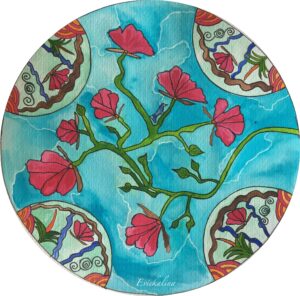
I am integrating different modalities I was trained including Art Therapy, Sand Therapy, Counselling, and other methods I picked up on my journey
When I first started counseling for myself, I found it was a bit daunting just to talk, and I felt I was getting nowhere. I also wanted to be heard, and I found it hard to find a practitioner who was listening and would be switched on. So I wanted to do it a little differently to help others take the weight off of things we don’t usually talk about, but have to.
This method helps to translate what we may be experiencing.
Send an email or text message. I’m also happy to chat with you on the phone to see what you may need, and then you can decide if you are feeling at ease with me and continue from there.
Book Now!
Art therapy
offers numerous benefits for individuals facing mental health challenges. Here are some key ways it can be beneficial:
- Expression of Emotions: Art therapy provides a non-verbal outlet for individuals to express feelings that may be difficult to articulate. Through creative processes, clients can explore and communicate their emotions, leading to greater self-awareness.
- Stress Reduction: Engaging in creative activities can reduce stress and promote relaxation. The act of creating art can serve as a meditative practice, helping individuals to calm their minds and alleviate anxiety.
- Improved Self-Esteem: Completing art projects can foster a sense of accomplishment and boost self-esteem. As individuals create and share their work, they often gain confidence in their abilities and value.
- Exploration of Identity: Art therapy allows individuals to explore their identity and personal experiences in a safe environment. This exploration can facilitate healing and help clients understand their thoughts and feelings more deeply.
- Processing Trauma: For those who have experienced trauma, art therapy can be a powerful tool. It offers a way to process and confront traumatic experiences without the need to recount them verbally, which can be overwhelming.
- Enhanced Coping Skills: Creating art can teach individuals effective coping strategies for managing stress and emotional challenges. It encourages problem-solving and resilience as they navigate the creative process.
- Social Connection: Participating in group art therapy sessions fosters a sense of community and belonging. Individuals can connect with others who share similar experiences, reducing feelings of isolation.
- Mindfulness and Focus: The process of creating art encourages mindfulness, helping individuals to focus on the present moment. This practice can lead to improved emotional regulation and decreased symptoms of anxiety and depression.
- Holistic Approach: Art therapy considers the whole person—mind, body, and spirit. It integrates cognitive, emotional, and physical aspects of healing, promoting overall well-being.
- Personal Insight: The creative process can unveil insights and reflections about one’s life and challenges. This self-discovery can lead to personal growth and a deeper understanding of one’s mental health journey.
Overall, art therapy is a versatile and effective therapeutic approach that can significantly enhance mental health outcomes for individuals.
So what is Transpersonal Art Therapy?
When you decide to see a Transpersonal Art Therapist, it is an opportunity for you to experience counselling a little differently than the way counselling normally operates. We move away from only talking. In addition to talking, you can create and use different art materials or sand. Using these processes allows self-growth and healing.
Sometimes my clients are not ready to talk or may find it hard to talk, and it’s OK. We can use different methods to make a transition into healing. Images can do the talking for us. Here are some ways we can use Art Therapy:
- Transpersonal art therapy goes beyond traditional art therapy to explore the unconscious and symbolic contents of the mind. This can be you creating a picture, drawing, collage, or clay work. You can also bring something you created already and talk through it, following your symbology and your meanings.
- Sand Therapy is something we can use as well if you are ready to work with a situation in your life and would like to have more clarity around it, as creating a tray
It is an effective approach to mental health. It is non-threatening and non-verbal, you can control the process, and you can safely take risks with materials and imagery whilst being supported. As a Trained Transpersonal Art Therapy Practitioner, I assist people in building relationships with themselves and others.
“I found myself smiling at my world that appeared in the images or stories I wrote, and they didn’t seem as scary anymore when appearing on paper or in the sand.” E.M.
We are all so different and have unique personalities and stories. There is no one-size-fits-all in counseling. This is the beauty of the transpersonal approach and you. Let’s celebrate who you are and where you are at.
A good video to look at what you may be able to do to express
https://www.youtube.com/watch?v=v0dgjSG4CpA
Some other modalities I was trained in are
Adv. Dip Tp Art Therapy
Adv. Dip TP Counselling
Dip. Integrated Psychotherapy
Mental Health Cert IV
AOD Cert IV
Cert in Life Coaching
Years of Acting/Theatre growing up
I am married and a Mother of 2 adult children
Dog person and Daisy
In the following modalities, I know of but do not practice anymore
Past Life regression training /not practiced
Astral travel training /not practiced
Energy healing modalities /not practiced
Psychic readings /not practiced
yoga /not practiced
04 00 2323 78
Email: eviekalina@gmail.com
Useful Links
Art therapy and attachment


